GLIDER and WHEELS are sold, Z5 HARNESS still available
Please click on archive list lower right of this page, or go here for harness details, and thanks for checking in.
News & Video on Light-Sport Aircraft, Sport Pilot Kits, and Ultralight Aircraft
Please click on archive list lower right of this page, or go here for harness details, and thanks for checking in.
By Dan Johnson || Leave a Comment

eLazair photo courtesy EAA | See EAA’s cool in-flight video and watch for our fact-filled video here on ByDanJohnson.com!

Snap, an aerobatic single-place LSA, gets upside down. photos courtesy SportairUSA

Evektor’s highly refined Harmony LSA. photo courtesy Lightning LS-1 sold several copies at AirVenture 2011. photo courtesy Arion Aircraft

Backyard Flyer is a Part 103 ultralight featuring an electric start four-stroke engine and a one-piece wing that swings 90 degrees for storage or transport. photo courtesy UltralightNews

EAA featured the Salute to Quicksilver at AirVenture 2011. The Southern California company has sold 15,000 of these and bagged four more at Oshkosh.
Oshkosh 2011 is history. By numerous accounts, this was a vast improvement over 2010 when the comments commonly went, “Well, I had some interest (in my airplane) and I hope to sell one or two… maybe.” This year I had easily 30 conversations revealing either outright positive successful results or varyingly robust mood indicators such as, “Looks like aviation has life in it again.” I heard from sellers and customers and rarely had to solicit their opinions. *** A number of aircraft purveyors said they took cash deposits and wrote firm contracts. I estimate about 30 aircraft sales by this method. Companies like Icon, Flight Design, and Terrafugia sold a large number of future delivery positions (more than 50, more than 60, and “several,” respectively). *** Icon neared or crossed the 500-on-order point, partly by “testing elasticity” in the pre-order market by lowering the A5 seaplane deposit to $2,000 from $5,000. *** Flight Design continued their tear from Aero adding dozens more orders for their four-seat C4, reporting more than $16 million in orders. These two and the roadable car maker continue to capture generous media attention and to present their stories impressively. *** Companies reporting sales for near-term delivery include Jabiru USA, Arion, Czech Sport, Evektor, Quicksilver, and Corbi, each logging from 2 to 7 sales. Arion transacted both SLSA and Experimental orders of their gorgeous LS-1. The preceding list is not inclusive as I didn’t hear from a number of companies regarding their results. *** Demo ride pilots also stayed very busy. Phoenix USA did more than 20, all out of lovely little Brennand Airport, 15 miles north of Oshkosh. SeaRey designer Kerry Richter reported 35 seaplane demos at EAA’s Seaplane Base. Pipistrel ran steadily, also at Brennand, except when they helped UltralightNews and me as we performed our first “full length” video, two-person pilot report on the new Evektor Harmony LSA (in two words: sophisticated & sweet). *** On the industry side, LAMA and GAMA (GA Mfrs Assoc.) held the first of a series of LSA leadership meetings. From last year at AirVenture the change in support for LSA at the highest levels of aviation was dramatic. Last year we remained somewhat ugly cousins deserving only an arm’s-length embrace. This year it was more a clap-on-the-back, glad-to-have-you-in-the-club greeting… though, of course, professionally delivered as these are the Big Boys of aviation. LAMA gave its 20th President’s Award to Cessna’s former president Jack Pelton, who reiterated his strong support for the LSA concept and promised to carry pro-industry messages when he meets this week as part of small, select group that advises FAA boss Randy Babbitt. Most of the conversation is likely to involve FAA’s current budget problems but the LSA sector represents good news for the agency. *** Visitors saw several new LSA at the show (Snap, electric Lazair, Harmony LSA, tri-gear Kolb Mk III, Remos NXT, and four seaters from LSA producers: Flight Design C4 and Tecnam P2010). Again, this list is not exhaustive and we’ll have more on these and other unveilings in coming days. *** True-103 ultralights flying with electric motors continued to draw big crowds in the Ultralight Area, which I thought looked stronger than in recent years. We also found and shot video reviews of interesting machines in the Ultralight Area: Kolb’s Mk III tri-gear/taildragger (yes, it goes both ways… at the same time!); the Part 103 welded-aluminum, swing-wing Backyard Flyer; the return of Terry Raber’s $14,000 ready-to-fly Aerolite-103; Earthstar’s all-electric eGull; plus a review of all the Hirth engines and an updated video on the Quad City Challenger. In the weeks ahead, we expect to post more than dozen fresh videos. *** Finally, ByDanJohnson.com enlisted several new sponsors to help us keep bringing you all the news of light aviation, nearly all of it free thanks to these supporters and the support of all our members. This year’s Oshkosh made me very happy to remain in this where-the-action-is industry. Lots more to come… click back soon!
 Oshkosh 2011 is history. By numerous accounts, this was a vast improvement over 2010 when the comments commonly went, “Well, I had some interest (in my airplane) and I hope to sell one or two… maybe.” This year I had easily 30 conversations revealing either outright positive successful results or varyingly robust mood indicators such as, “Looks like aviation has life in it again.” I heard from sellers and customers and rarely had to solicit their opinions. *** A number of aircraft purveyors said they took cash deposits and wrote firm contracts. I estimate about 30 aircraft sales by this method. Companies like Icon, Flight Design, and Terrafugia sold a large number of future delivery positions (more than 50, more than 60, and “several,” respectively). *** Icon neared or crossed the 500-on-order point, partly by “testing elasticity” in the pre-order market by lowering the A5 seaplane deposit to $2,000 from $5,000.
Oshkosh 2011 is history. By numerous accounts, this was a vast improvement over 2010 when the comments commonly went, “Well, I had some interest (in my airplane) and I hope to sell one or two… maybe.” This year I had easily 30 conversations revealing either outright positive successful results or varyingly robust mood indicators such as, “Looks like aviation has life in it again.” I heard from sellers and customers and rarely had to solicit their opinions. *** A number of aircraft purveyors said they took cash deposits and wrote firm contracts. I estimate about 30 aircraft sales by this method. Companies like Icon, Flight Design, and Terrafugia sold a large number of future delivery positions (more than 50, more than 60, and “several,” respectively). *** Icon neared or crossed the 500-on-order point, partly by “testing elasticity” in the pre-order market by lowering the A5 seaplane deposit to $2,000 from $5,000.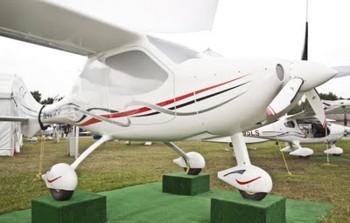

Remos GX NXT upgrade model


Leading Edge intake for new cabin vents


Two SkyViews and an Aera 500…oh boy.

Top-notch interior features rearranged knobs, smoother workflow


Room With A View…what a wonderful age we live in.
By all accounts it’s been a good show. I talked with several LSA vendors who, despite the pitiful wrangling in Congress over the debt and general lack of a strong economic bounceback, either wrote some sales or were 90% certain they would. *** U.S. sales leader Flight Design even announced they’d written $11 million worth of business at the show. *** I talked with John Gilmore, the U.S. sales manager for Tom Peghiny’s U.S. Flight Design operation, who briefed me on the new, four-seat, to-be-certified Flight Design C4 the other day (I’ll post more in the next few days). *** John also updated Dan Johnson today on the company’s excellent numbers at the show: *** “We have taken 40 orders for the new C4 plus another 8 orders for Light-Sport Aircraft here at AirVenture 2011,” said John. *** The C4 debuted in Europe in April and a full-scale mockup seen here was prominent in the display all week. Historical note: Flight Design has topped the LSA sales leader board since the category was created in 2004, an impressive run due in large part to an excellent management style and top customer support and service.I was up at the crack o’ dawn to fly the new Remos NXT, which has some new features such as a new panel profile that gives more viewing room on top and more leg room underneath — very nice and it definitely feels roomier. The avionics upgrade features Garmin Aera 500 GPS, and the Dynon SkyView glass cockpit with electronic flight instruments, embedded transponder, and engine monitoring. Dynon is winning over cockpits left and right with the SkyView, and no wonder: it’s got it all, at a price that’s magnitudes cheaper than equivalent certified glassworks. *** The NXT also refines placement of some control knobs in the cockpit and adds visors and air vents to keep things cool. *** Personally my flight in beautiful, calm dawn air reinforced my impression from my flight report 18 months back that there is no finer LSA of the 30 or so I’ve flown so far in terms of sheer joyful handling. I hadn’t flown one in all that time, yet made two greaser landings with hardly any coaching from my demo host, Ryan Hernandez, who admirably handled the Oshkosh chores for Arkansas dealer Tommy Lee and his Adventure Flight dealership. *** The Remos turns so smoothly, is so light on the controls yet not twitchy or oversensitive at all, and as I said back then, as soon as you lift off, you feel like you’ve been flying the airplane every day. Really quite an achievement in aerodynamics for Remos. *** It’s beautiful interior is a testimony to the fit and finish of the entire plane. In you’re in the market for a comfortable, really fun-flying LSA, certainly put Remos on the list. I know it’s on my top ten (a list that constantly changes as I fly more airplanes…but Remos has stayed there since my first flight. *** One closing note then on to the show, time to line up some last flights and say goodbye to friends and colleagues in the industry. *** It’s not an LSA-centric product, but this cute idea, Mutt Muffs, reminds us that any time we go flying with our sensitive-hearing furry friends means we want to help them enjoy the ride too. ‘Nuff said. *** Scroll down for more pix of the Remos GX NXT upgrade model below. *** I’ll have another pickup blog for Oshkosh probably in two-three days as I’m flying home in the new Evektor Harmony with AB Flight’s Art Tarola *** tomorrow…if we can get all our gear into one airplane!
 By all accounts it’s been a good show. I talked with several LSA vendors who, despite the pitiful wrangling in Congress over the debt and general lack of a strong economic bounceback, either wrote some sales or were 90% certain they would. *** U.S. sales leader Flight Design even announced they’d written $11 million worth of business at the show. *** I talked with John Gilmore, the U.S. sales manager for Tom Peghiny’s U.S. Flight Design operation, who briefed me on the new, four-seat, to-be-certified Flight Design C4 the other day (I’ll post more in the next few days). *** John also updated Dan Johnson today on the company’s excellent numbers at the show: *** “We have taken 40 orders for the new C4 plus another 8 orders for Light-Sport Aircraft here at AirVenture 2011,” said John. *** The C4 debuted in Europe in April and a full-scale mockup seen here was prominent in the display all week.
By all accounts it’s been a good show. I talked with several LSA vendors who, despite the pitiful wrangling in Congress over the debt and general lack of a strong economic bounceback, either wrote some sales or were 90% certain they would. *** U.S. sales leader Flight Design even announced they’d written $11 million worth of business at the show. *** I talked with John Gilmore, the U.S. sales manager for Tom Peghiny’s U.S. Flight Design operation, who briefed me on the new, four-seat, to-be-certified Flight Design C4 the other day (I’ll post more in the next few days). *** John also updated Dan Johnson today on the company’s excellent numbers at the show: *** “We have taken 40 orders for the new C4 plus another 8 orders for Light-Sport Aircraft here at AirVenture 2011,” said John. *** The C4 debuted in Europe in April and a full-scale mockup seen here was prominent in the display all week.
Calin Gologan, the freshly bestowed LEAP Award, and Elektra One. Exciting times ahead.



Remos GX getting some help from the line dude. Lots and lots of traffic today.

LSA Mall seemed to be buzzing all day long…


Nice air plenum in the Alto 100 sends cooling air over the canopy. An integrated heating element defrost too…I bet Ron Corbi will sell a lot of these.

Hansen Air Group’s gorgeous FK12 Comet acro S-LSA is here too…so much foot traffic has come, it’s worn out the grass next to the plane!

busy busy busy

Randy Schlitter’s newly reworked S7 with cool

New balanced ailerons for the S7

Legend Aircraft’s new Super Legend. Lovely!
It’s late, I got heat stroked a bit in the beautiful but intensely sunny day so I’m going to post some pix of some things I saw at the show with short captions and will hope to get back with more details once my feet stop throbbing and my brain temps cool down a bit. *** A beautiful day in Oshkosh. Everybody was catching up on flying after being in the gloom and doom for two days. *** The electric symposium went off well, I assume, although I missed it, had to try and get in a thrice-postponed flight with Remos… which was postponed yet again. Bummer. That’s happening now at 6 am… about 7 hours from now. Yark! *** I had a nice chat with Calin Gologan, the extremely tall creator of the Elektra One that won the Lindbergh LEAP award today. He told me they have achieved a battery storage density improvement that will allow them to make a 500 mile flight in Germany, they hope, this August. *** A very nice, very brilliant man. *** The Corbi Air Alto 100 was there, with an installed air conditioner! Very nice install, they’ll be selling them to experimental builders and LSA makers too.
 It’s late, I got heat stroked a bit in the beautiful but intensely sunny day so I’m going to post some pix of some things I saw at the show with short captions and will hope to get back with more details once my feet stop throbbing and my brain temps cool down a bit. *** A beautiful day in Oshkosh. Everybody was catching up on flying after being in the gloom and doom for two days. *** The electric symposium went off well, I assume, although I missed it, had to try and get in a thrice-postponed flight with Remos… which was postponed yet again. Bummer. That’s happening now at 6 am… about 7 hours from now. Yark! *** I had a nice chat with Calin Gologan, the extremely tall creator of the Elektra One that won the Lindbergh LEAP award today. He told me they have achieved a battery storage density improvement that will allow them to make a 500 mile flight in Germany, they hope, this August.
It’s late, I got heat stroked a bit in the beautiful but intensely sunny day so I’m going to post some pix of some things I saw at the show with short captions and will hope to get back with more details once my feet stop throbbing and my brain temps cool down a bit. *** A beautiful day in Oshkosh. Everybody was catching up on flying after being in the gloom and doom for two days. *** The electric symposium went off well, I assume, although I missed it, had to try and get in a thrice-postponed flight with Remos… which was postponed yet again. Bummer. That’s happening now at 6 am… about 7 hours from now. Yark! *** I had a nice chat with Calin Gologan, the extremely tall creator of the Elektra One that won the Lindbergh LEAP award today. He told me they have achieved a battery storage density improvement that will allow them to make a 500 mile flight in Germany, they hope, this August.




A year ago I did a blog piece here as well as a piece in the magazine about the resurrected “Lazarus Machine”, Renegade Light Sport’s super sexy low wing, about-to-be Lycoming IO-233-LSA-powered, all composite S-LSA. *** I found Renegade’s prime mover Christopher “Doc” Bailey at the flashy Lycoming display and before I could say “Lightning round!” he was regaling me, as only Doc can do, with the leaps and bounds the company has made in the last year. *** I’m going to serve up the rapid-fire infostream in his own words, but before I do, here’s the short tell: the Falcon is done with testing, is in production, comes in two configurations, tricycle and taildragger, sells for $125,000 with a bunch of nice features (including 10″ Dynon SkyView, full Garmin stack and dual electronic ignition) and if your mouth isn’t watering yet, I’m stepping to the side and take it away Doc! *** “The first production model Renegade Falcon with the Lycoming IO-233-LSA is owned by our dealer on Long Island, NY – Steve Norman. It’s the airplane you see right here (and in the photos).” *** “The engine is FAA Part 33 certified. The airframe is ASTM certified. We’re done with R&D, we’ve been through a year of testing with the 233. We’ve tested six fuel injection systems, five electronic ignition systems (and settled on the Lightspeed dual ignition system), four different exhaust systems (and settled on the Vetterman exhaust), and three or four panel mounts. We just brought on the Catto 3-blade, nickel-edge composite prop, we also tested Sensenich and others.” *** “And we’re getting 1500 fpm climb solo, 4.6 gph cruise at 2400 rpm, and we’re just where we said we would be in a year.” *** “We’ve put in 100 hours of test flying so far.” *** “This airplane, Steve Norman’s, has everything you can get, the stuff I mentioned and dual Grand Rapids Synthetic Vision with built-in highway in the sky and autopilot; a ballistic chute, ostrich skin seats…” *** Real ostrich skins? I asked. *** “You bet, I’m the one who paid for them, they were real alright!” *** “So many guys came up and said they’d flown Cubs and other taildraggers all their lives, and when 500 people tell you they want that, you better take notice! So we now have a taildragger version too, with beefy, durable 7071-T6 gear for flight schools and a Matco 42-degree breakaway tailwheel.” *** “We’ve got five engines coming from Lycoming this month, we’ve sold six airplanes since we’ve been here at the show, we’re in full production here, everything is built in the U.S., we have a new autoclave system set up by former Boeing engineers, and like I said we’ve come a long way in a year.” *** “Before the prop has turned 45 degrees, the ignition system is producing a 120,000 volt spark and the engine starts right up like a car. We call this engine the Rotax Slayer! We’re getting 305 degrees on the CHT, 1000 degrees on the EGT, so it’s burning efficiently and burning cool. We’re placarding max level rpm at 2400 to maintain the 120-knot LSA restriction.” *** “Future enhancements will include room for golf clubs, wing locker baggage, winglets for more stability, things like that.” *** I asked how fast it was now at full power. “You don’t want me to tell you that,” he said with a laugh. “It’s fast. We’ll placard it at 2400 rpm for 120 knots. We had a CFII bring it out here from Kansas City. He was doing 140 knots at 2700 rpm.” *** “People ask me, ‘Why not restrict the engine?’ That’s a huge safety issue for me. If you’re downwind to land and the wind falls out, you may need all the power you can get. Why restrict that? If you go over that 2400 rpm setting, it’s on you legally but I’m not going to take it away. It’s like CubCrafters did with their 180 hp engine, placarding it to a max of five minutes full power.” *** “The first production taildragger Falcon is going to Switzerland, to the guy who started the Swatch company. We’ve got orders for five, with seven airframes done, we can make five a month and all of it is out of our Lees Summit, MO plant.” *** “Weight for the taildragger is 795 lbs. For the tricycle gear it’s 814, with everything installed. It gets off in 200-300 feet easily. Before you get the throttle all the way up, it’s already rotated.” *** “It will throw you back into the seat; with the Catto prop you really feel the thrust. It really takes off. We figure we’re getting 123-125 hp with the fuel injection. With the traditional carbureted version, we were getting 120 knots at 2750 rpm. With the fuel injection, we dropped 300 rpm to get the same speed, at the same altitude and in the same weather. It just feels smoother. We think it’s that 120,000 volt spark. It was burning 5.5 gph with the carburetion: with electronic ignition, it’s 4.6.” *** All that’s left now is for me to fly it for a pirep which I hope to do here at the show and let you know how much of this is real, and how much is “Doc”-ese! *** One last word: the airplane, already a winner in the looks department, has a beautiful engine installation. It’s clean, it’s elegant, it’s beautiful. And, for those “graying” types Doc talks about who still don’t trust the well-proven Rotax, the Lycoming is the deal-maker. It’ll be interesting to see how much support this all-American, $125K looker garners in the market place.
 A year ago I did a blog piece here as well as a piece in the magazine about the resurrected “Lazarus Machine”, Renegade Light Sport’s super sexy low wing, about-to-be Lycoming IO-233-LSA-powered, all composite S-LSA. *** I found Renegade’s prime mover Christopher “Doc” Bailey at the flashy Lycoming display and before I could say “Lightning round!” he was regaling me, as only Doc can do, with the leaps and bounds the company has made in the last year. *** I’m going to serve up the rapid-fire infostream in his own words, but before I do, here’s the short tell: the Falcon is done with testing, is in production, comes in two configurations, tricycle and taildragger, sells for $125,000 with a bunch of nice features (including 10″ Dynon SkyView, full Garmin stack and dual electronic ignition) and if your mouth isn’t watering yet, I’m stepping to the side and take it away Doc!
A year ago I did a blog piece here as well as a piece in the magazine about the resurrected “Lazarus Machine”, Renegade Light Sport’s super sexy low wing, about-to-be Lycoming IO-233-LSA-powered, all composite S-LSA. *** I found Renegade’s prime mover Christopher “Doc” Bailey at the flashy Lycoming display and before I could say “Lightning round!” he was regaling me, as only Doc can do, with the leaps and bounds the company has made in the last year. *** I’m going to serve up the rapid-fire infostream in his own words, but before I do, here’s the short tell: the Falcon is done with testing, is in production, comes in two configurations, tricycle and taildragger, sells for $125,000 with a bunch of nice features (including 10″ Dynon SkyView, full Garmin stack and dual electronic ignition) and if your mouth isn’t watering yet, I’m stepping to the side and take it away Doc!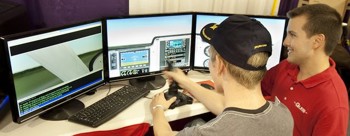
Gleim’s Aaron Wiseman takes a showgoer through a sample flight lesson

Aaron Wiseman pointing out flight-realistic EFIS readings

Fully customizable screen and audio warnings keep students on the straight and narrow

One section of the center screen shows how detailed and true-to-life the simulator is.
Today was not a typical Oshkosh day, and certainly nothing like yesterday, which was downright idyllic with its sunny skies, refreshing mid-70s temps and puffy clouds to complete the chromatic joys of a perfect green summer day in Great Lakes country. *** In short, it rained until late afternoon, but by sundown the skies mostly cleared with the promise of hotter, more humid days ahead. Today was the perfect kind of day to walk around, dodge the liquid sunshine, meet and greet old friends and make new ones, and see what’s shaking in the main display hangars and booths strewn all over Airventure. *** I’d wanted to check out the Gleim X-Plane VFR Flight Simulator I’ve heard so much about. I had the benefit of a stirring presentation by Aaron Wiseman, who energetically took me through all the main features of the system which has caught on at a number of flight schools already. *** It’s cool! A really effective approach to flight simulation that can also save flight schools and their students real money. *** Being able to realistically drill and anchor in-flight control feel, situational awareness and cockpit procedure skills before students actually get in that infamous “worst classroom in the world”, while also shortening expensive flight training hours,without breaking the bank, should appeal to flight schools wanting higher student completion rates…and what school doesn’t want that? One of several advantages of the sim is how instructors can take a student through a full flight lesson on the ground, help students through rough patches, pause the routine and explain new concepts or problem areas, then take the student out for a practical lesson in the airplane when ready. *** There’s a lot to say about Dr. Irv Gleim’s latest brainchild, and for that I urge you to go check out the info online here. *** Be sure and watch the video at the bottom of the page for a quick intro. *** For now, I’ve only got room (and late-night energy) to point out some key points. *** [] The three-screen system, complete with Dell XPS computer, three screens, stick, throttle and rudder pedals (flight school version) is dramatically cheaper (around $5000) than similar simulators which cost tens of thousands of dollars. *** [] Students can install a less-expensive version on their own home computer (many of us have two screen systems now, so only a third screen would be required). The private user version is still in development and should market in the next few months. *** [] It was developed for use in Remos Pilot Centers and has become very effective through continual feedback refinement with Gleim’s programmers. The system I worked with was set up for a Remos GX and it was suitably smooth, light on the controls (I was constantly over controlling until I relaxed a bit) and very realistic. *** The three screens give an excellent panorama view, and the background can be located right at the airport where students are being trained, and conform to the type of aircraft they’re training in, for even more realistic — and transferable to the cockpit — skills. *** Lou Mancuso of Mid Island Air Service of Long Island, who’s had a lot of success training people in LSA for several years now, raves about this system. *** Thanks again to Aaron Wiseman for his thorough briefing. I’ll be writing more on this in my Oshkosh top new products article for the magazine.
 Today was not a typical Oshkosh day, and certainly nothing like yesterday, which was downright idyllic with its sunny skies, refreshing mid-70s temps and puffy clouds to complete the chromatic joys of a perfect green summer day in Great Lakes country. *** In short, it rained until late afternoon, but by sundown the skies mostly cleared with the promise of hotter, more humid days ahead. Today was the perfect kind of day to walk around, dodge the liquid sunshine, meet and greet old friends and make new ones, and see what’s shaking in the main display hangars and booths strewn all over Airventure. *** I’d wanted to check out the Gleim X-Plane VFR Flight Simulator I’ve heard so much about. I had the benefit of a stirring presentation by Aaron Wiseman, who energetically took me through all the main features of the system which has caught on at a number of flight schools already.
Today was not a typical Oshkosh day, and certainly nothing like yesterday, which was downright idyllic with its sunny skies, refreshing mid-70s temps and puffy clouds to complete the chromatic joys of a perfect green summer day in Great Lakes country. *** In short, it rained until late afternoon, but by sundown the skies mostly cleared with the promise of hotter, more humid days ahead. Today was the perfect kind of day to walk around, dodge the liquid sunshine, meet and greet old friends and make new ones, and see what’s shaking in the main display hangars and booths strewn all over Airventure. *** I’d wanted to check out the Gleim X-Plane VFR Flight Simulator I’ve heard so much about. I had the benefit of a stirring presentation by Aaron Wiseman, who energetically took me through all the main features of the system which has caught on at a number of flight schools already.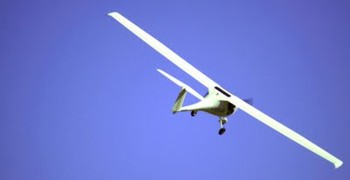


San Antonio Light Sport Aircraft’s Rand Vollmer


After my own Labors of Hercules, I arrived at the EAA Oshkosh Airventure seasonal highpoint event Tuesday mid day. Since it was a beautiful day by anybody’s standards, I decided not to brave the hordes at the show and headed out, once I got settled in my digs for the week, to a lovely little airport named Brennand about 10 minutes northwest of EAA’s Wittman Field show grounds. *** I was in luck with more than just weather: the San Antonio Light Sport Aircraft (SALSA) gang from Texas was there demo-flying its all-composite Pipistrel Virus SW 80/100, tricycle-gear (there’s also a taildragger version), composite touring motorglider. *** The Pipistrel line includes several designs I have admired from afar but not had the opportunity to share air with. *** All that changed when Salsa’s prime mover and shaker Rand Vollmer introduced me to a big, friendly Texican fella named Dave White. *** Dave is Salsa’s Sales Director, chief glider/motorglider instructor and demo pilot out at Brennand Airport, which, by the way, is one of those lovely, quiet airport communities I think we should all get to live on either in this life or the next one. Green grass and trees, lovely homes, quiet, no hassle backyard flying: can’t ask for much more than that. Anyway, Dave said, “Hey, I just had a demo cancel, want to go up?” *** Do Pope wear tall, funny looking hat? *** Ten minutes later I was taxiing the light-handling, 40-foot span Virus — which as everyone hastens to mention is a terrible name for a wonderful airplane. It comes from Slovenia, where virus is pronounced “vee-roos”, which sounds a whole lot better than the way we say it). *** The wonderful-airplane part is fully realized after just a few minutes. I haven’t flown anything but a Cub for the last 3 months so I’m stomping that poor airplanes rudder rather mercilessly, but the airplane doesn’t seem to mind at all. And in just a takeoff, a couple turns and listening to Dave obligingly talk me through everything — and letting me really get to know the airplane by letting me do everything, a wonderful teaching style — I’ve learned one important thing: The Virus SW is a real sleeper of an S-LSA. Check out this video: *** I’ll have a pilot report on it in the magazine soon. *** The Cliff Notes version: *** Virus handles more like a plane with a 30-foot span, has a 45-45 roll rate around two seconds, has light, balanced control feel, turns quickly and with virtually no adverse yaw — I pulled turns left and right without any rudder at all and it obliged with nary a complaint. *** The airplane, which is built for lightness and thus has a 660 lb. useful load — though it’s max weight is more than a hundred pounds below the LSA ceiling weight of 1320 lbs.!, hangs on in soaring turns to the lightest little bug fart of a thermal, which became evident in calm, 6:30 p.m. air where I, the newcomer, was able to make a few turns in just a bit of a bubble and approach zero sink for a few seconds. *** Glide ratio by the way is 24:1 and sink rate is around 250 fpm. That’s plenty good enough to shut down and let the earth/sun/sky engine keep you up for hours. And the robust top-o’-wing, hand-lever pop up air brakes give great glide-slope control for landing. Dave demonstrated a most impressive dead-stick landing using only the brakes for putting her down on the narrow paved strip at Brennand. *** Handling is light and nimble, cruise is ridiculously efficient — we saw 112 knots at 80% power and remember, the engine is an 80hp, not 100hp, Rotax. The Euro version which isn’t restricted to top speed approaches 150 knots max level cruise! Yes, a very, very clean airframe, and you feel that when you fly it. It’s a joy, very forgiving too (especially with that big span). *** Salsa has a variety of motorgliding training and buying options. And you won’t find many places better to earn your soaring chops than the big-thermal country of Texas, where numerous soaring records have been set for decades. *** Give these guys a closer look, they’re fully dedicated and devoted to demonstrating the benefits that learning to fly powered soaring aircraft bestow, not only on new and experienced pilots, but on the future of GA itself. *** Their brief thesis, which I’ll explore with Rand in the article more fully, is that pilots can get their glider rating much cheaper than any other ratings, learn a great deal about flying, and have much more fun at it than merely crunching through the syllabi and getting handed a certificate. *** Motorgliding, they believe, creates pilots who experience and learn to understand the vital nuances of flight in a way that will stick with them throughout their flying lives. *** Pipistrel has showed up in a big way this year with a choice display in front of Hangar B near Airshow Central or whatever they’re calling it now. *** Prominent is its Taurus Electro G4, the 3,000lb.+, four-seat, all-electric motorglider that’s competing at September’s CAFE Green Flight Challenge. The two-fuselage aircraft is drawing a lot of attention, and once all the requrements to compete legally (as Experimental Exhibition aircraft since there is yet to be an FAA standard for electric-powered aircraft) are met it should have a good shot at winning the $1.3 million prize. *** Jim Lee of PhoEnix, the electric version built for the race that’s in test and development now, tells me there are so many hurdles for so many of the entrants, it may be postponed again. It was originally scheduled for earlier this month but nobody was ready. *** Off to the show…in the rain!
 After my own Labors of Hercules, I arrived at the EAA Oshkosh Airventure seasonal highpoint event Tuesday mid day. Since it was a beautiful day by anybody’s standards, I decided not to brave the hordes at the show and headed out, once I got settled in my digs for the week, to a lovely little airport named Brennand about 10 minutes northwest of EAA’s Wittman Field show grounds. *** I was in luck with more than just weather: the San Antonio Light Sport Aircraft (SALSA) gang from Texas was there demo-flying its all-composite Pipistrel Virus SW 80/100, tricycle-gear (there’s also a taildragger version), composite touring motorglider. *** The Pipistrel line includes several designs I have admired from afar but not had the opportunity to share air with. *** All that changed when Salsa’s prime mover and shaker Rand Vollmer introduced me to a big, friendly Texican fella named Dave White.
After my own Labors of Hercules, I arrived at the EAA Oshkosh Airventure seasonal highpoint event Tuesday mid day. Since it was a beautiful day by anybody’s standards, I decided not to brave the hordes at the show and headed out, once I got settled in my digs for the week, to a lovely little airport named Brennand about 10 minutes northwest of EAA’s Wittman Field show grounds. *** I was in luck with more than just weather: the San Antonio Light Sport Aircraft (SALSA) gang from Texas was there demo-flying its all-composite Pipistrel Virus SW 80/100, tricycle-gear (there’s also a taildragger version), composite touring motorglider. *** The Pipistrel line includes several designs I have admired from afar but not had the opportunity to share air with. *** All that changed when Salsa’s prime mover and shaker Rand Vollmer introduced me to a big, friendly Texican fella named Dave White.By Dan Johnson || Leave a Comment
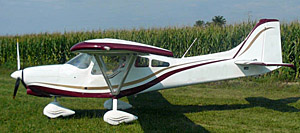
Spirit is SLSA #120. photo courtesy World Aircraft Co.

Spirit was designed in Columbia and is assembled in Paris… Tennessee. photo courtesy World Aircraft Co.

Spirit shows a nicely-appointed cockpit. photo courtesy World Aircraft Co.

…and an ample baggage area. photo courtesy World Aircraft Co.
Way over in Paris a new airplane has arrived just as large numbers of pilots head to Oshkosh for AirVenture. Only this Paris is in Tennessee as reviewed earlier. SLSA #120 Spirit comes from a new company but one whose leader earned his SLSA pedigree gaining four model approvals. That would be Skykits and their STOL variations. All are designs from ICP of Italy (Savannah, plus ADV and VG models of the Savannah). FAA considered them a different models so our SLSA List accepted them as such. Then Skykits brought out the Rampage, their own variation of another ICP design. *** Skykits refined those initial approvals into three birds: Savannah VG with fixed-position leading edge slats accented with vortex generators; Savannah VGW, a larger version of the VG in a wide body form with bubble doors; and Rampage with electrically-deployable leading edge slats trailed by Fowler flaps. *** Now from proprietor Eric Giles comes World Aircraft Company (WAC) formed in partnership with a Central American engineer. “Spirit is the culmination of 45 years of aircraft design by MIT aeronautical engineer Max Tedesco,” writes WAC in boasting about their new design guru. “Max put his heart and soul into Spirit.” Tedesco hails from Columbia where he created the design. *** WAC continues, “Our Spirit is fast, roomy, has a sumptuous interior, and carries a greater payload than any Light-Sport airplane on the market.” (See Note at bottom.) “While Spirit has a 260 foot takeoff, it is not an ugly box like some STOL airplanes,” observed WAC. “In fact, Spirit is a beautifully engineered masterpiece from its monoquoe fuselage to its unique, truly original, non-NACA wing.” *** Spirit arrives on the market for five bucks under $100,000 and has a worthy list of standard features. A kit is available for less than $40,000 with the 912 mount package but not including the engine, interior, or a few other essentials. Kit options vary enough that you’ll want to contact the company for details. *** Here’s another U.S.-built aircraft to add to the growing SLSA fleet… #120. Congratulations to the new World Aircraft Company.
* Preliminary specs supplied by WAC state, “Weight full fuel: 728 pounds.” Pilot are used to reading empty weight and fuel capacity but WAC does some math for you. Since it carries 24 gallons of fuel (144 pounds), empty weight calculates to a modest 584 pounds. At that empty weight the claim “Payload with full fuel: 592 pounds” is certainly generous although I did not compare its payload with all other SLSA.
 Way over in Paris a new airplane has arrived just as large numbers of pilots head to Oshkosh for AirVenture. Only this Paris is in Tennessee as reviewed earlier. SLSA #120 Spirit comes from a new company but one whose leader earned his SLSA pedigree gaining four model approvals. That would be Skykits and their STOL variations. All are designs from ICP of Italy (Savannah, plus ADV and VG models of the Savannah). FAA considered them a different models so our SLSA List accepted them as such. Then Skykits brought out the Rampage, their own variation of another ICP design. *** Skykits refined those initial approvals into three birds: Savannah VG with fixed-position leading edge slats accented with vortex generators; Savannah VGW, a larger version of the VG in a wide body form with bubble doors; and Rampage with electrically-deployable leading edge slats trailed by Fowler flaps.
Way over in Paris a new airplane has arrived just as large numbers of pilots head to Oshkosh for AirVenture. Only this Paris is in Tennessee as reviewed earlier. SLSA #120 Spirit comes from a new company but one whose leader earned his SLSA pedigree gaining four model approvals. That would be Skykits and their STOL variations. All are designs from ICP of Italy (Savannah, plus ADV and VG models of the Savannah). FAA considered them a different models so our SLSA List accepted them as such. Then Skykits brought out the Rampage, their own variation of another ICP design. *** Skykits refined those initial approvals into three birds: Savannah VG with fixed-position leading edge slats accented with vortex generators; Savannah VGW, a larger version of the VG in a wide body form with bubble doors; and Rampage with electrically-deployable leading edge slats trailed by Fowler flaps.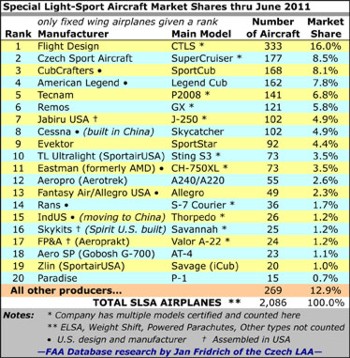

CubCrafters continues to show strong market share
Winged buddy Dan Johnson and his colleague Jan Fridrich, head of LAMA Europe, just posted Jan’s exhaustive parsing of the LSA registration data and came up with some shockers. *** Dan calls it the LSA Market Share Report. The first thing he notes is apparent stability in the marketplace: overall registration numbers for the first half of 2011 are about the same as last year, he says, so at least the industry didn’t fall off from that tough year. The pace is on track to better 2009’s 177 total registrations and 2010’s 202. *** In 2010, 48 came from Cessna, which, when subtracted from the total, gives you 154 for the whole year for the rest of the fleet. *** So, looking again at 2011’s first half of 126, subtracting Cessna’s numbers from the total of 126 yields just 72. *** Double that (144) and we could end up with even fewer registrations than 2010, (not counting Cessna) although at just 10 less it’s not an earthshaking falloff unless you want to be a worrywart and consider 2009, which had 177 total…and none from Cessna. But we won’t go there. *** As has been the trend from the beginning, just a handful — six this time — LSA companies racked up 92% of all new registrations! *** Remember, these aren’t sales on the book but previous (or future) sales, since these numbers only reflect aircraft registered from Jan. through June with FAA. For instance, several LSA might come in at one time to a dealer, who might register them all at once before selling any of them. Or vice versa: some already sold may not have been registered. Still, the reg numbers provide a pretty accurate glimpse of what’s really going on. *** And The Gang of Six? *** Cessna: 54, for almost 43% of all registrations, on the strength of Skycatching-up in production *** CubCrafters: 20 for 17% *** Czech Aircraft Works: 16 for 13%, which includes formerly-badged PiperSports *** American Legend: 11 for 9% *** Flight Design (still #1): 10 for 7%. *** Jabiru: 5 for 4% *** That’s 116 aircraft out of the total of 126. *** Now if we throw in Aeropro (Aerotrek models) and its 4 registrations, those top 7 companies account for just over 95% of all 2011 registrations! That means of all the other 112 manufacturers, only 6 aircraft made the books.That, my friends, is a hard number to swallow for all those hardy, perservering companies who are still in the game mostly, as the numbers suggest, on a wing and a lot of prayers. *** Dan goes on to point out that eight makers have now sold more than 100 aircraft. In an economy as enduringly painful as a chronic bad tooth, that’s somewhat encouraging. *** And even though only 126 aircraft were registered since January 19th…well, 126 aircraft were registered since January 19th! In other words, the industry is not throwing in the towel, though it’s sure getting a drenching. *** Another bellweather of sorts: Cessna’s healthy production has for the first time tipped the market scales toward the U.S.: we registered more aircraft than offshore producers in 2011. *** Cessna is now 8th (13th six months ago), based on 54 Skycatchers registered. That’s like watching an insider stock chart shoot for the moon! *** And with a goodly percentage of those highly-touted initial 1000 orders still on the books, Cessna will only continue to leapfrog the rest at the top of the list for the foreseeable future, at least until purse strings not only among the merely well-off but the uber-rich loosen up, because right now, not many people in any income category are buying much of anything considered a luxury. *** Some surprising numbers, as my reader Thomas pointed out in a comment to my previous blog post: *** Five major makers, all in the top 20, narrowly missed striking out completely in registrations the first six months! *** Four of them — Tecnam, TL Ultralight (Sting), Eastman (Zodiac models) and Evektor (SportStar), failed to register a single ship. Only Remos tallied…one. It registered 32 in 2009! What’s happening here? *** Eastman is working on a comeback after several fatal crashes and a subsequent airframe redesign, but the other four produce a variety of excellent quality aircraft and enjoy good reputations. Pricing on any of their models is not by and large out of line with the rest of the market. *** Thomas goes into the shadows with this: “It’s not that there’s no demand: SportCruiser, Cessna, CubCrafters and Flight Design all registered decent numbers of aircraft. Was the owner experience of these other aircraft not so good? Support not there? Wrong features? Parts problems? Airframe failures? Or did the distributor simply bring in too much inventory, register it all at once, and then spend the last 2 years not registering any new ones while steadily selling off the inventory?” *** All are reasonable inquiries. I’m particularly drawn to his support and inventory sell-off conjectures. Airframe failures have been at a minimum. Owner experience is difficult to gauge: what one person tells a private buddy may never reach many public ears, rumor mongers though we pilots tend to be. *** It’s hard to see a clear picture for four of those five companies not tallying. It’s worth some digging; I’ll have Dr. Watson and my magnifying glass at the ready at Oshkosh, which starts in just three days!
 Winged buddy Dan Johnson and his colleague Jan Fridrich, head of LAMA Europe, just posted Jan’s exhaustive parsing of the LSA registration data and came up with some shockers. *** Dan calls it the LSA Market Share Report. The first thing he notes is apparent stability in the marketplace: overall registration numbers for the first half of 2011 are about the same as last year, he says, so at least the industry didn’t fall off from that tough year. The pace is on track to better 2009’s 177 total registrations and 2010’s 202. *** In 2010, 48 came from Cessna, which, when subtracted from the total, gives you 154 for the whole year for the rest of the fleet. *** So, looking again at 2011’s first half of 126, subtracting Cessna’s numbers from the total of 126 yields just 72. *** Double that (144) and we could end up with even fewer registrations than 2010, (not counting Cessna) although at just 10 less it’s not an earthshaking falloff unless you want to be a worrywart and consider 2009, which had 177 total…and none from Cessna.
Winged buddy Dan Johnson and his colleague Jan Fridrich, head of LAMA Europe, just posted Jan’s exhaustive parsing of the LSA registration data and came up with some shockers. *** Dan calls it the LSA Market Share Report. The first thing he notes is apparent stability in the marketplace: overall registration numbers for the first half of 2011 are about the same as last year, he says, so at least the industry didn’t fall off from that tough year. The pace is on track to better 2009’s 177 total registrations and 2010’s 202. *** In 2010, 48 came from Cessna, which, when subtracted from the total, gives you 154 for the whole year for the rest of the fleet. *** So, looking again at 2011’s first half of 126, subtracting Cessna’s numbers from the total of 126 yields just 72. *** Double that (144) and we could end up with even fewer registrations than 2010, (not counting Cessna) although at just 10 less it’s not an earthshaking falloff unless you want to be a worrywart and consider 2009, which had 177 total…and none from Cessna.By Dan Johnson || Leave a Comment
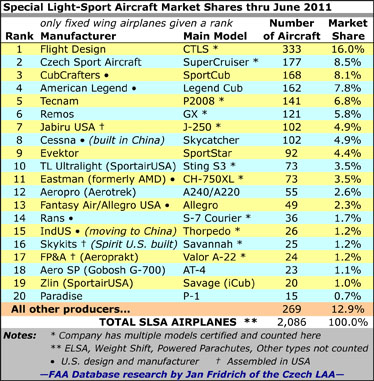

Arion’s Lightning, an all-American design, is close to entering the Top 20. photo courtesy Arion Aircraft

Renegade’s Falcon was first to fly with Lycoming’s O-233 LSA variant engine.
Several readers have asked and we are finally delivering. Jan Fridrich and I present the LSA Market Share Report for the first half of 2011. Figures show a mimicking of 2010 output and that was not a strong year. However, the numbers are not down from 2010 so you could see stability if not growth. *** In the first half of 2011 six companies account for almost 90% of registrations and Cessna alone accounted for precisely half of these. The other five producers: CubCrafters (17% of all first half 2011 deliveries), Czech Aircraft Works (including PiperSport, 13%), Flight Design (7%), Jabiru (4%), and Aerotrek (3%). *** The Over-100 Club now has eight members (chart) up from six at the end of 2010. Our numbers reflect total fleet size, so growth measured this way is inevitable. This method of illustrating market share identifies the strongest producers since 2005. To reveal rising brands that don’t make the Top 20, we use text references. In this period, that includes the Arion Lightning and the Renegade Falcon. While not yet making the Top 20 both are aircraft to watch. Each is U.S. built and in this metric we see the most surprising aspect of this report… *** U.S. manufacturers have overtaken European producers. While unquestionably an American brand, some readers will question Skycatcher’s national origin (think Apple and their devices… designed in the U.S. / built overseas). But that doesn’t change the fact of American designs for the first time out-registering European brands in the first half of 2011. *** Cessna has risen to be the market leader for 2011, moving up to 8th from 13th place in our Top 20, based on 54 registrations this year. Their potential would seem potent considering the Wichita giant reported 1,000 orders. Some industry observers expressed that the Chinese manufacturing operation proved difficult to start. Additionally, Cessna may have allowed things to run slower both to improve quality and perhaps because some customers might cancel their Skycatcher orders if pushed to take them in this difficult economy. *** Let’s keep aviation production figures in perspective. According to multiple sources, airplanes are not the only challenged industry. Marina owners who used to sell plenty of large boats are struggling and RV manufacturers are having a tough time; one billon-dollar corporation (Monaco) entered bankruptcy. The misery of this sluggish economy touches many. As one expert put it, “Airplanes, even Light-Sports, are luxury items and except for the super rich, many otherwise well-to-do persons are holding back on spending.” Meanwhile, the stronger companies are moving upward and the Light-Sport industry’s many small players can be extremely tenacious. As the U.S/EU economies improve, LSA are the most likely to benefit thanks to lower prices and great qualities.
 Several readers have asked and we are finally delivering. Jan Fridrich and I present the LSA Market Share Report for the first half of 2011. Figures show a mimicking of 2010 output and that was not a strong year. However, the numbers are not down from 2010 so you could see stability if not growth. *** In the first half of 2011 six companies account for almost 90% of registrations and Cessna alone accounted for precisely half of these. The other five producers: CubCrafters (17% of all first half 2011 deliveries), Czech Aircraft Works (including PiperSport, 13%), Flight Design (7%), Jabiru (4%), and Aerotrek (3%). *** The Over-100 Club now has eight members (chart) up from six at the end of 2010. Our numbers reflect total fleet size, so growth measured this way is inevitable. This method of illustrating market share identifies the strongest producers since 2005.
Several readers have asked and we are finally delivering. Jan Fridrich and I present the LSA Market Share Report for the first half of 2011. Figures show a mimicking of 2010 output and that was not a strong year. However, the numbers are not down from 2010 so you could see stability if not growth. *** In the first half of 2011 six companies account for almost 90% of registrations and Cessna alone accounted for precisely half of these. The other five producers: CubCrafters (17% of all first half 2011 deliveries), Czech Aircraft Works (including PiperSport, 13%), Flight Design (7%), Jabiru (4%), and Aerotrek (3%). *** The Over-100 Club now has eight members (chart) up from six at the end of 2010. Our numbers reflect total fleet size, so growth measured this way is inevitable. This method of illustrating market share identifies the strongest producers since 2005.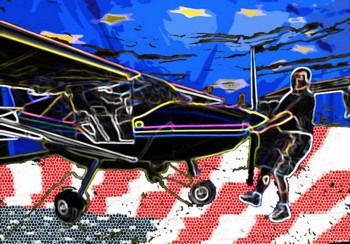

FAA’s European doppelganger is EASA ( European Aviation Safety Agency), a governmental body which has wrestled with how to “regulate the new kid” for some time. *** And EASA has at last come out with its much-anticipated CS-LSA, or Certification Specification for Light-Sport Aircraft. *** American makers have eagerly awaited the announcement so they could at least consider how they might better compete with the many LSA producers overseas that have dominated our domestic market (roughly 2 out of every 3 LSA sold here come from offshore). *** Although CS-LSA, as industry insider Dan Johnson reports, is “not exactly what the industry hoped for, it at least represents acceptance of the ASTM certification standards.” *** The benefit extends to all manufacturers foreign and domestic, since uncertainty over whether LSA aircraft produced for America, under the ASTM certification, would ever be legal to sell in Europe has been a stumbling block for Yankee sellers since the creation of LSA here in 2004. *** Light sport aircraft in Europe, known as ultralights and microlights, was already a thriving industry over there, and contributed to their acceptance here even as American makers scrambled to create, refine, upgrade and promote their own Light Sport designs. *** Working against everybody for some time has been the market’s Perfect Storm trifecta : *** 1. A high Dollar/Euro exchange rate (currently $1.41 per €1) which imposed high prices for all European-made LSA sold in this country *** 2. The Economy, duh. *** 3. The higher-than-anticipated cost of LSA from all makers foreign and domestic. *** Perhaps the biggest impact of CS-LSA on American companies will be that they can finally sell their ASTM-certified aircraft overseas. And the high Dollar to Euro exchange rate means American aircraft would be attractively priced to Europeans: they get an effective 30% discount. A U.S. aircraft priced at $90,000 would cost €60,000 over thar. *** But knocking that in the head is the nature of the CS-LSA spec itself, which incorporates many expenses not incurred in certifying aircraft to the ASTM spec in America. *** CS-LSA provides, as LAMA Europe’s head Jan Fridrich points out in Dan’s blurb on this topic, “merely another airworthiness code, which a manufacturer can choose in lieu of full EASA Type Certification.” That’s as in millions-of-dollars full. *** Say whuh? He means even under CS-LSA, any manufacturer must still get DOA (Design Organization Approval) and POA (Production Organization Approval) from EASA to produce aircraft for sale under under the new category. Which still means a significant cash outlay above and beyond typical ASTM certification costs that could run into hundreds of thousands of bucks for each model. Why? EASA charges fees for those standards. In our country, FAA’s oversight is funded by, yep, you and me, the taxpayers. Although the current debt reduction free-for-all in Congress might change that here too, who knows where that’s going? *** On top of all that, EASA also charges annual fees to keep those standards current. *** So Mr. Dan speculates this all could mean, if CS-LSA isn’t revised more favorably down the road, one of two things: *** 1. Bigger companies could pay the EASA charges and fold the increase into sales prices. *** 2. Smaller companies could say, “Nein”, throw up their hands and bail out of the entire business, finding the cost of competition too great. *** Bottom line: higher prices likely, at least for European-produced LSA. Americans who choose not to sell overseas might actually improve their appeal cost-wise here, while their EASA-conforming competition ponies up and suffers the need to produce pricier aircraft, even as those smaller European producers drop out of the game. *** One ray of hope in all of this lies in LAMA Europe’s ongoing push for a more “self-declarative” adjustment to the CS-LSA specification, which would lower or remove those added DOA and POA costs and help many companies choose to stay in business. *** Otherwise it could indeed be DOA for several companies who have hung in there all this time hoping to jump into the European market without incurring typical EASA and FAA full certification costs. *** Probably the best part of this news is that ASTM, doing well here in the U.S., now has a good foothold overseas, which expands its potential influence on light aircraft production worldwide.
 FAA’s European doppelganger is EASA ( European Aviation Safety Agency), a governmental body which has wrestled with how to “regulate the new kid” for some time. *** And EASA has at last come out with its much-anticipated CS-LSA, or Certification Specification for Light-Sport Aircraft. *** American makers have eagerly awaited the announcement so they could at least consider how they might better compete with the many LSA producers overseas that have dominated our domestic market (roughly 2 out of every 3 LSA sold here come from offshore). *** Although CS-LSA, as industry insider Dan Johnson reports, is “not exactly what the industry hoped for, it at least represents acceptance of the ASTM certification standards.” *** The benefit extends to all manufacturers foreign and domestic, since uncertainty over whether LSA aircraft produced for America, under the ASTM certification, would ever be legal to sell in Europe has been a stumbling block for Yankee sellers since the creation of LSA here in 2004.
FAA’s European doppelganger is EASA ( European Aviation Safety Agency), a governmental body which has wrestled with how to “regulate the new kid” for some time. *** And EASA has at last come out with its much-anticipated CS-LSA, or Certification Specification for Light-Sport Aircraft. *** American makers have eagerly awaited the announcement so they could at least consider how they might better compete with the many LSA producers overseas that have dominated our domestic market (roughly 2 out of every 3 LSA sold here come from offshore). *** Although CS-LSA, as industry insider Dan Johnson reports, is “not exactly what the industry hoped for, it at least represents acceptance of the ASTM certification standards.” *** The benefit extends to all manufacturers foreign and domestic, since uncertainty over whether LSA aircraft produced for America, under the ASTM certification, would ever be legal to sell in Europe has been a stumbling block for Yankee sellers since the creation of LSA here in 2004.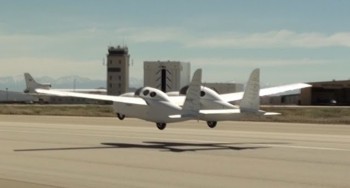
BiPod lifts off (sans props) for initial test flights. All images courtesy Aviation Week & Space Technology



The Scaled Composites crew. Burt Rutan is seen 4th from left
Okay, so no way this is ever going to be a Light Sport aircraft, but this is just too much fun and I had to pass it along. *** Famed aircraft designer Burt Rutan has been at it again, this time with his eclectic take on a flying car that began life as an electric-powered flying testbed. *** Aviation Week’s online blog (also picked up by Wired magazine) shared information released exclusively to it by Rutan’s Scaled Composites company known in recent years for many fantastic projects including Spaceship One and White Knight. *** Called BiPod, the flying car became a crash program, completed in just four months and already in test flight mode. Rutan himself retired in April of this year. *** Model 367 BiPod is characteristically, wonderfully unconventional as have been all of Rutan’s many designs. *** The two-seat, hybrid-electric “roadable” aircraft (mini-rant: I sure hope that term doesn’t replace flying car, which flows off the tongue much more agreeably, don’t you think?), originally conceived as a fast, inexpensive electric aircraft, morphed into a flying car. The program was hurried along, says Aviation Week, to allow Rutan to shepherd it through to completion before he hung up his cad cam computer’s mouse. He was in the shop cutting, fabricating and sanding many nights long after the rest of the team went home. *** First “flight” was last March 30. The unusual-looking carplane has made several short hops at Scaled’s Mojave, California airport location. *** And the hops were just that: speed, built up from battery-powered driving wheels, was translated into short glides above the runway. Fun stuff! *** The fully operational BiPod will carry two 450cc gas engines, one per fuselage, which will drive generators feeding an electric power system. In land mode, the system will drive motors in the driving wheels at the aft location of each fuselage pod. The forward wheels are steerable. *** During flight, the power grid will drive four 15kW motor-driven props: one on each nose, two on the horizontal stabilizer. *** Good old Burt: you can never count out his sheer design originality. *** Lithium batteries fill the nose of both pods. They are inflight-rechargeable and will augment takeoff power from the two engines. *** Think of the advantages for driving with disagreeable companions (mothers-in-law?) too. They can ride in the right hand pod, leaving the driver in the left pod, in blissful silence. *** Interestingly, only the throttle is common to both…cockpits? Car interiors? Carpits? Your choice: driving is exclusively from the left pod, and flying is done from the right. Hmmm…that means mischief could still be done from the other pod by a cranky passenger. *** Span is almost 32 feet. Wings detach for driving. Cruise speed in flight: 200mph with max range of 750 miles at 100 mph. *** Driving, BiPod can go at freeway speeds for 820 miles on a tank of gas or 35 miles on batteries alone. *** It’ll be fascinating to watch what happens with this project. It’s a bit challenging to imagine this project ever coming to the market. Taking a road trip with the fam separated into two compartments seems strange…although anyone with surly teenagers (or those poor, traditionally maligned mothers-in-law) will easily see some potential benefits.
 Okay, so no way this is ever going to be a Light Sport aircraft, but this is just too much fun and I had to pass it along. *** Famed aircraft designer Burt Rutan has been at it again, this time with his eclectic take on a flying car that began life as an electric-powered flying testbed. *** Aviation Week’s online blog (also picked up by Wired magazine) shared information released exclusively to it by Rutan’s Scaled Composites company known in recent years for many fantastic projects including Spaceship One and White Knight. *** Called BiPod, the flying car became a crash program, completed in just four months and already in test flight mode. Rutan himself retired in April of this year. *** Model 367 BiPod is characteristically, wonderfully unconventional as have been all of Rutan’s many designs. *** The two-seat, hybrid-electric “roadable” aircraft (mini-rant: I sure hope that term doesn’t replace flying car, which flows off the tongue much more agreeably, don’t you think?), originally conceived as a fast, inexpensive electric aircraft, morphed into a flying car.
Okay, so no way this is ever going to be a Light Sport aircraft, but this is just too much fun and I had to pass it along. *** Famed aircraft designer Burt Rutan has been at it again, this time with his eclectic take on a flying car that began life as an electric-powered flying testbed. *** Aviation Week’s online blog (also picked up by Wired magazine) shared information released exclusively to it by Rutan’s Scaled Composites company known in recent years for many fantastic projects including Spaceship One and White Knight. *** Called BiPod, the flying car became a crash program, completed in just four months and already in test flight mode. Rutan himself retired in April of this year. *** Model 367 BiPod is characteristically, wonderfully unconventional as have been all of Rutan’s many designs. *** The two-seat, hybrid-electric “roadable” aircraft (mini-rant: I sure hope that term doesn’t replace flying car, which flows off the tongue much more agreeably, don’t you think?), originally conceived as a fast, inexpensive electric aircraft, morphed into a flying car.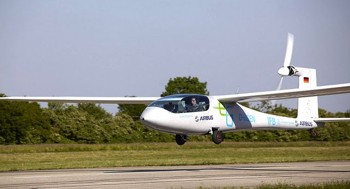

The eGenius electric motor — 60kW (80.5 hp equivalent)
A crack team of aeronautical whizbrains in the Institute of Aircraft Design at the University of Stuttgart, Germany has just passed its second important milestone in less than two months: its electric aircraft eGenius just flew more than two hours at more than 100 mph. *** Not by coincidence, that’s exactly the kind of performance that will be required to take $1.3 million top prize in the recently postponed (until September 25) CAFE Green Flight Challenge. *** The GFC will award the prize money to the aircraft that can fly 200 miles at greater than 100 mph on the equivalent of one gallon of gas per occupant. The per occupant proviso is significant…and EGenius carries two people, so it can use enough batteries to store two gallons worth of energy. *** That’s a lot of batteries given the current relative inefficiency of energy storage of batts vs. gas, but it appears that hurdle has been overcome, and rather handily, since there was apparently several minutes of charge left after the record-breaking flight.The eGenius, funded by Airbus, is an electric motorglider, with the requisite high-aspect wing (55 feet). It’s powered by a 60 kW (80.5 hp) motor, installed in the tail to drive a larger, more efficient prop. The battery pack can stow 56 kWh of energy. *** Flight profile included a climb to 4000 feet and an out-and-back between two nearby towns. Total distance was 211 miles, a world record for electric flight. *** This on the heels of its maiden flight in May. *** If the other entries (12 at last count) in September’s GFC big-money event aren’t shaking in their boots yet…they oughta be. It’s a stunning development and augurs well for advancing the technology by at least one leap and bound…the point of the contest in the first place. *** Let me say it again: Wow!
 A crack team of aeronautical whizbrains in the Institute of Aircraft Design at the University of Stuttgart, Germany has just passed its second important milestone in less than two months: its electric aircraft eGenius just flew more than two hours at more than 100 mph. *** Not by coincidence, that’s exactly the kind of performance that will be required to take $1.3 million top prize in the recently postponed (until September 25) CAFE Green Flight Challenge. *** The GFC will award the prize money to the aircraft that can fly 200 miles at greater than 100 mph on the equivalent of one gallon of gas per occupant. The per occupant proviso is significant…and EGenius carries two people, so it can use enough batteries to store two gallons worth of energy. *** That’s a lot of batteries given the current relative inefficiency of energy storage of batts vs.
A crack team of aeronautical whizbrains in the Institute of Aircraft Design at the University of Stuttgart, Germany has just passed its second important milestone in less than two months: its electric aircraft eGenius just flew more than two hours at more than 100 mph. *** Not by coincidence, that’s exactly the kind of performance that will be required to take $1.3 million top prize in the recently postponed (until September 25) CAFE Green Flight Challenge. *** The GFC will award the prize money to the aircraft that can fly 200 miles at greater than 100 mph on the equivalent of one gallon of gas per occupant. The per occupant proviso is significant…and EGenius carries two people, so it can use enough batteries to store two gallons worth of energy. *** That’s a lot of batteries given the current relative inefficiency of energy storage of batts vs.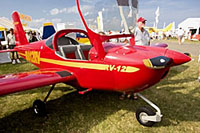


I’ve written about the topic of high-hour pilots and the need for transitioning them into LSA a fair amount now. *** I’ve also heard about it from and talked to a lot of people about it. Avemco Insurance, before they took a hiatus from writing new LSA policies a couple months back, wrote a minimum of 5 hours mandatory transition training into their premium contracts with pilots, stipulating, basically, this: “We don’t care if you be Sully Sullenburger or Wiley Post incarnate. If you want us to insure you in your new LSA, you will get five hours flight training in it.” *** Stumbling around the net the other day, I found this excellent piece written by Ed Downs for In Flight USA, in which he lays out the need, in particular, for veteran pilots to check the uber-confidence at the hangar door and give LSA full respect as unique aircraft with distinct behaviors. *** Definitely worth reading if you’re at all of the LSA = “little airplanes” persuasion.
 I’ve written about the topic of high-hour pilots and the need for transitioning them into LSA a fair amount now. *** I’ve also heard about it from and talked to a lot of people about it. Avemco Insurance, before they took a hiatus from writing new LSA policies a couple months back, wrote a minimum of 5 hours mandatory transition training into their premium contracts with pilots, stipulating, basically, this: “We don’t care if you be Sully Sullenburger or Wiley Post incarnate. If you want us to insure you in your new LSA, you will get five hours flight training in it.” *** Stumbling around the net the other day, I found this excellent piece written by Ed Downs for In Flight USA, in which he lays out the need, in particular, for veteran pilots to check the uber-confidence at the hangar door and give LSA full respect as unique aircraft with distinct behaviors.
I’ve written about the topic of high-hour pilots and the need for transitioning them into LSA a fair amount now. *** I’ve also heard about it from and talked to a lot of people about it. Avemco Insurance, before they took a hiatus from writing new LSA policies a couple months back, wrote a minimum of 5 hours mandatory transition training into their premium contracts with pilots, stipulating, basically, this: “We don’t care if you be Sully Sullenburger or Wiley Post incarnate. If you want us to insure you in your new LSA, you will get five hours flight training in it.” *** Stumbling around the net the other day, I found this excellent piece written by Ed Downs for In Flight USA, in which he lays out the need, in particular, for veteran pilots to check the uber-confidence at the hangar door and give LSA full respect as unique aircraft with distinct behaviors.By Dan Johnson || Leave a Comment
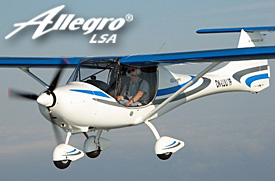
Allegro is now built in the USA. photo courtesy LSA America

Lightly built, Allegro has proven it can perform the tough duty of training. photo courtesy LSA America

Allegro comes in for landing with a student at the controls. photo courtesy LSA America
LSA America now produces the Allegro in Littleton, North Carolina and anticipates their first U.S.-produced LSA approval before Oshkosh 2011. Despite Czech-based Fantasy Air’s ceasing manufacturing several years ago, Allegro did well enough in the first couple years to still retain the #14 rank. *** Exciting as this now-Made-in-the-USA story may be, this article has a different focus. I want to tell you about an older Allegro, one that has logged more than 3,500 hours, nearly all of them doing training. *** With a few other long-serving LSA that I’ve been told about, this addresses the matter about Light-Sports being durably built to perform instructional flying over an extended period. Some pilots believe lightly built LSA cannot handle the duress of students learning to fly. *** Allegro (N50631) appears to disprove the argument that LSA aren’t tough enough. New factory operator Doug Hempstead stated, “The composite fuselage has proven itself in a flight school setting and aluminum wings make [Allegro] affordable to repair.” He continued, “[Our trainer] is an Allegro 2000, the design built from 2000 to 2006.” It was put in service at B Bar D Aviation Flight School with 200 hours. Doug said, “We now have over 3,500 hours total time and are barely 500 hours from our second engine overhaul.” *** While doing some of the hardest duty in aviation he reports this particular trainer has experienced but a handful of maintenance cancellations. “We recorded only two weeks of down time in six years,” stated Hempstead. “One hundred hour inspections take about eight hours and are often done overnight to avoid flight training disruptions.” *** “We are logging about 90 hours a month on this aircraft and total figures for 2010 were 1,085 hours,” boasted Doug. “Our peak month logged 145 hours.” During 2010, the flight school soloed 20 people; of those 17 now have either their Sport or Private Pilot Certificates. Another student went on to earn his Sport CFI and now works for Doug and Betty Hempstead. “From our first solo in October 2005 we have soloed 84 students 11 of which now own Allegros,” Doug noted. “Another 44 people have gotten their BFRs and became current again. Each of these people had lapsed flying from 2 to 15 years.” *** All this yet Allegro is one of the lightest LSA. With a max takeoff weight of 1,320 pounds, empty weight is just 622 pounds on average, yielding a max useful load of 698 pounds. Since Allegro holds 17 gallons (102 pounds), payload is an impressive 596 pounds. A few other specs: stall with flaps extended 40 mph; cruise at 75% 120 mph; climb 1,000 fpm; glide 12:1. Come see the Allegro at the LSA Mall at Oshkosh 2011 or check LSA America’s display in the ultralight area, space 933.
 LSA America now produces the Allegro in Littleton, North Carolina and anticipates their first U.S.-produced LSA approval before Oshkosh 2011. Despite Czech-based Fantasy Air’s ceasing manufacturing several years ago, Allegro did well enough in the first couple years to still retain the #14 rank. *** Exciting as this now-Made-in-the-USA story may be, this article has a different focus. I want to tell you about an older Allegro, one that has logged more than 3,500 hours, nearly all of them doing training. *** With a few other long-serving LSA that I’ve been told about, this addresses the matter about Light-Sports being durably built to perform instructional flying over an extended period. Some pilots believe lightly built LSA cannot handle the duress of students learning to fly. *** Allegro (N50631) appears to disprove the argument that LSA aren’t tough enough. New factory operator Doug Hempstead stated, “The composite fuselage has proven itself in a flight school setting and aluminum wings make [Allegro] affordable to repair.” He continued, “[Our trainer] is an Allegro 2000, the design built from 2000 to 2006.” It was put in service at B Bar D Aviation Flight School with 200 hours.
LSA America now produces the Allegro in Littleton, North Carolina and anticipates their first U.S.-produced LSA approval before Oshkosh 2011. Despite Czech-based Fantasy Air’s ceasing manufacturing several years ago, Allegro did well enough in the first couple years to still retain the #14 rank. *** Exciting as this now-Made-in-the-USA story may be, this article has a different focus. I want to tell you about an older Allegro, one that has logged more than 3,500 hours, nearly all of them doing training. *** With a few other long-serving LSA that I’ve been told about, this addresses the matter about Light-Sports being durably built to perform instructional flying over an extended period. Some pilots believe lightly built LSA cannot handle the duress of students learning to fly. *** Allegro (N50631) appears to disprove the argument that LSA aren’t tough enough. New factory operator Doug Hempstead stated, “The composite fuselage has proven itself in a flight school setting and aluminum wings make [Allegro] affordable to repair.” He continued, “[Our trainer] is an Allegro 2000, the design built from 2000 to 2006.” It was put in service at B Bar D Aviation Flight School with 200 hours.By Dan Johnson || Leave a Comment
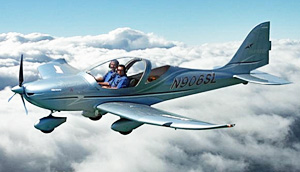
Evektor’s new Harmony SLSA will make a first U.S. appearance at AirVenture 2011. photo courtesy Evektor/Dreams Come True

Evektor has tapered the wings from the Sportstar’s “Hershey Bar” shape, easily seen in this view. photo courtesy Evektor/Dreams Come True

Harmony is now SLSA #119. photo courtesy Evektor/Dreams Come True
Evektor will always be First… that is, the Czech company gained the very first Special Light-Sport Aircraft approval back in April 2005 and no one can ever take that first-in-class title away from them. Now they are also the newest approval, before AirVenture 2011 anyway. Congratulations to Evektor Aerotechnik and their U.S. representatives including Steve Minnich’s Dreams Come True operation in Dayton, Ohio. *** “I got a call right at lunch time that the Evektor Harmony LSA, N905EH, just received her airworthiness certificate,” Steve wrote on July 13th. How is Harmony different than the SportStar series (SE, Plus, Max, Max IFR)? Steve helped out with an informative summary. *** “The wing and tail surfaces are tapered and the wings and horizontal stabilizer have greater span so the wing area is actually the same. Both rudder and ailerons are larger giving a higher crosswind capability and the rudder pedal linkages exit through the floor rather than penetrating the firewall. Even the firewall is extended 100 mm (approx. 4 inches) so the rudders not only adjust in three positions, but now may be mounted in 3 locations. This new flexibility gives tall pilots an option to move the whole rudder assembly forward, or move it aft if shorter folks are going to be flying regularly. The wheel pants (which Europeans sometimes call ‘spats’), and gear leg fairings have been redesigned and are closer fitting and more aerodynamic. There are other refinements that are important, though less obvious. The rudder/brake pedals truly are aviation style components.” *** Steve continued, “The canopy latch has been changed to a double latch similar to an automotive style providing both a latched and a locked position. The fuel bypass now returns to both tanks not just the left and those tanks now hold 31 gallons. The nose gear has been redesigned and the steering, still directly linked, has been changed so the sensitivity is ground adjustable. Finally, an optional air handling unit is now available for positive air circulation while on the ground.” *** The wing and empennage treatment may seem subtle at first but on closer examination, the Harmony enjoys more refined lines. Evektor has constantly been improving this benchmark aircraft and this 2011 model takes that to the limit. Come see the new Harmony at AirVenture 2011 in space 441, just east of the new FAA control tower. See you there!
 Evektor will always be First… that is, the Czech company gained the very first Special Light-Sport Aircraft approval back in April 2005 and no one can ever take that first-in-class title away from them. Now they are also the newest approval, before AirVenture 2011 anyway. Congratulations to Evektor Aerotechnik and their U.S. representatives including Steve Minnich’s Dreams Come True operation in Dayton, Ohio. *** “I got a call right at lunch time that the Evektor Harmony LSA, N905EH, just received her airworthiness certificate,” Steve wrote on July 13th. How is Harmony different than the SportStar series (SE, Plus, Max, Max IFR)? Steve helped out with an informative summary. *** “The wing and tail surfaces are tapered and the wings and horizontal stabilizer have greater span so the wing area is actually the same. Both rudder and ailerons are larger giving a higher crosswind capability and the rudder pedal linkages exit through the floor rather than penetrating the firewall.
Evektor will always be First… that is, the Czech company gained the very first Special Light-Sport Aircraft approval back in April 2005 and no one can ever take that first-in-class title away from them. Now they are also the newest approval, before AirVenture 2011 anyway. Congratulations to Evektor Aerotechnik and their U.S. representatives including Steve Minnich’s Dreams Come True operation in Dayton, Ohio. *** “I got a call right at lunch time that the Evektor Harmony LSA, N905EH, just received her airworthiness certificate,” Steve wrote on July 13th. How is Harmony different than the SportStar series (SE, Plus, Max, Max IFR)? Steve helped out with an informative summary. *** “The wing and tail surfaces are tapered and the wings and horizontal stabilizer have greater span so the wing area is actually the same. Both rudder and ailerons are larger giving a higher crosswind capability and the rudder pedal linkages exit through the floor rather than penetrating the firewall.By Dan Johnson || 2 Comments
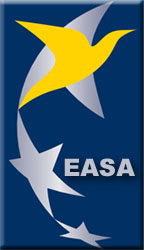
EASA (European Aviation Safety Agency) is roughly equivalent to FAA for the European Union.

Arion’s all-American Lightning could be a candidate for export to Europe, if they choose to afford the cost of EASA’s inspectors.

Rans has three SLSA models it could sell in Europe but sales may not justify the expense.
Try not to yawn. This is important. To see why, read “What does this mean…” below. *** EASA, roughly the equivalent of FAA for the European Union, finally released its CS-LSA, or Certification Specification for Light-Sport Aircraft. While not exactly what the industry hoped for, it at least represents acceptance of the ASTM certification standards. That reduces uncertainty for LSA producers in the European theater. For American producers hoping to sell across the Atlantic, CS-LSA presents an expensive choice. With the dollar low and the euro high, Made-in-the-USA aircraft could enjoy a price advantage if they could sell into Europe. *** If you’re an LSA manufacturer who must read this stuff, here’s the link to EASA’s “decision” and other documents. I plowed through this dense material but I also asked my counterpart in LAMA Europe to give me his view. *** Jan Fridrich is already known to you as the man who laboriously studies FAA’s LSA database to produce the figures I use to create our LSA market share reports. Jan said, “This is definitively a positive step from EASA, as they have practically accepted ASTM standards.” *** Jan explained further, “This is not a self-declarative system, however. It is merely another airworthiness code, which a manufacturer can choose in lieu of full EASA Type Certification.” Any manufacturer hoping to produce more than a prototype airplane must achieve Design Organization Approval (DOA) and Production Organization Approval (POA). Gaining those approvals can run tens to hundreds of thousands of dollars. *** Unlike FAA, which provides oversight with taxpayer dollars, EASA assesses Fees & Charges that are paid by the companies being reviewed. I have examined the fee chart and can confirm costs could add up to many thousands to win approval plus annual fees. |||| What does this mean to American LSA buyers? Assuming no improvement, this could go two ways. A larger company might pay EASA’s fees & charges and then factor some portion of those costs into the price they charge for their LSA. Or, smaller companies may simply say they cannot afford EASA’s bill and cease LSA production. Light-Sport Aircraft that are subject to EASA rules will experience upward price pressure. So either LSA meeting EASA rules get more expensive Or, your choices of LSA get narrower. *** Some observers might believe this could actually help American producers compete because two-thirds of our 118 SLSA presently come from Europe. Indeed, manufacturers selling to the USA that are based outside EASA jurisdiction might gain some price advantage. *** Because EASA charges nearly $300 per hour per man for a minimum of two inspectors, including every hour of their travel time (according to the Fees & Charges chart), a U.S. company wishing to sell LSA in Europe must spend a large sum of money gaining full approval… subject to wide variation depending on a company’s prior experience and preparation. LAMA Europe will continue its work to push for something closer to the U.S. self-declarative system but meanwhile, at least ASTM standards acceptance continues its global growth.
 Try not to yawn. This is important. To see why, read “What does this mean…” below. *** EASA, roughly the equivalent of FAA for the European Union, finally released its CS-LSA, or Certification Specification for Light-Sport Aircraft. While not exactly what the industry hoped for, it at least represents acceptance of the ASTM certification standards. That reduces uncertainty for LSA producers in the European theater. For American producers hoping to sell across the Atlantic, CS-LSA presents an expensive choice. With the dollar low and the euro high, Made-in-the-USA aircraft could enjoy a price advantage if they could sell into Europe. *** If you’re an LSA manufacturer who must read this stuff, here’s the link to EASA’s “decision” and other documents. I plowed through this dense material but I also asked my counterpart in LAMA Europe to give me his view. *** Jan Fridrich is already known to you as the man who laboriously studies FAA’s LSA database to produce the figures I use to create our LSA market share reports.
Try not to yawn. This is important. To see why, read “What does this mean…” below. *** EASA, roughly the equivalent of FAA for the European Union, finally released its CS-LSA, or Certification Specification for Light-Sport Aircraft. While not exactly what the industry hoped for, it at least represents acceptance of the ASTM certification standards. That reduces uncertainty for LSA producers in the European theater. For American producers hoping to sell across the Atlantic, CS-LSA presents an expensive choice. With the dollar low and the euro high, Made-in-the-USA aircraft could enjoy a price advantage if they could sell into Europe. *** If you’re an LSA manufacturer who must read this stuff, here’s the link to EASA’s “decision” and other documents. I plowed through this dense material but I also asked my counterpart in LAMA Europe to give me his view. *** Jan Fridrich is already known to you as the man who laboriously studies FAA’s LSA database to produce the figures I use to create our LSA market share reports.By Dan Johnson || Leave a Comment
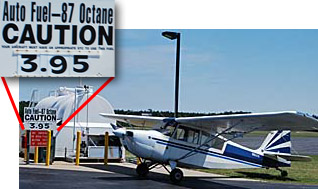
Mogas is arriving at more airports with better pricing and better engine results. LSA owners love this stuff.

California’s Clear Gas benefits pilots (of some 70-80% of all aircraft)…

…but boat enthusiasts can also use the fuel, which can sometimes be bought at airports exposing them to recreational aviation.
After a prolonged absence, mogas is returning to airports thanks to steady efforts by a consortium lead by Dean Billing and Kent Misegades. The numbers appear small today, even if they function to help you find cheaper and cleaner mogas as an alternative to 100LL. About 3% of airports presently offer mogas. But these numbers will go only one direction assuming recent fuel trends continue. While all fuel is getting more expensive, mogas remains much less costly than avgas. Since Rotax, Jabiru, and Lycoming accommodate automobile fuel blends now, since 100LL has a questionable future, and since the price of 100LL has always been substantially more than mogas, how cannot we expect mogas at airports to increase? *** The folks at Fly Unleaded have a growing list of airports offering the auto go-juice. The list is maintained by GAFuels co-author Dean Billing. While the number offering 100LL slowly drops, the mogas suppliers continues to grow. The converts just keep on coming. *** Writes Kent Misegades, “New England pilots have another reason to be happy this summer. Coming on the heels of news from earlier this month regarding the Sanford Regional Airport, we just learned that Dexter Regional Airport (1B0) in Dexter Maine, now offers 91 octane, ethanol-free, lead-free autogas for sale.” *** “The airport’s manager, Roger Nelson, described the new service, ‘We recently installed a dual-fuel self-service system consisting of two 5,200 gallon tanks for Avgas and Autogas. All but two of the aircraft based on the airfield use autogas, since it is what our pilots prefer. All of our hangars are now filled, we have a waiting list, and are planning to build more hangars.'” *** “Roger also stated that the airport will sell ethanol-free autogas to anyone, and has already made significant sales to boaters and landscaping companies for their for lawn equipment. ‘We had one person describe the $600 expense he had for repairs to his boat’s motor as a result of ethanol in gasoline’ noted Nelson. ‘Boaters in our area are happy to find a source of ethanol-free fuel at our airport, and we are seeing many new airplanes stopping in for a top-off.'” *** Even more recently, a grassroots effort started by recreational pilots in California’s Central Valley and supported by the free Aviation Fuel Club, Clear Gas is now ready to supply airports in that state with lead-free, ethanol-free premium autogas, an FAA-approved aviation fuel since 1982.
 After a prolonged absence, mogas is returning to airports thanks to steady efforts by a consortium lead by Dean Billing and Kent Misegades. The numbers appear small today, even if they function to help you find cheaper and cleaner mogas as an alternative to 100LL. About 3% of airports presently offer mogas. But these numbers will go only one direction assuming recent fuel trends continue. While all fuel is getting more expensive, mogas remains much less costly than avgas. Since Rotax, Jabiru, and Lycoming accommodate automobile fuel blends now, since 100LL has a questionable future, and since the price of 100LL has always been substantially more than mogas, how cannot we expect mogas at airports to increase? *** The folks at Fly Unleaded have a growing list of airports offering the auto go-juice. The list is maintained by GAFuels co-author Dean Billing. While the number offering 100LL slowly drops, the mogas suppliers continues to grow.
After a prolonged absence, mogas is returning to airports thanks to steady efforts by a consortium lead by Dean Billing and Kent Misegades. The numbers appear small today, even if they function to help you find cheaper and cleaner mogas as an alternative to 100LL. About 3% of airports presently offer mogas. But these numbers will go only one direction assuming recent fuel trends continue. While all fuel is getting more expensive, mogas remains much less costly than avgas. Since Rotax, Jabiru, and Lycoming accommodate automobile fuel blends now, since 100LL has a questionable future, and since the price of 100LL has always been substantially more than mogas, how cannot we expect mogas at airports to increase? *** The folks at Fly Unleaded have a growing list of airports offering the auto go-juice. The list is maintained by GAFuels co-author Dean Billing. While the number offering 100LL slowly drops, the mogas suppliers continues to grow.By Dan Johnson || Leave a Comment
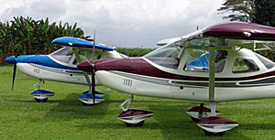
It happens that the boys from Zephyr Hills airport have two interesting machines and you ought to know about them. “Boys” in this case refers to Abid Farooqui, Larry Mednick, and Phil Mednick; the latter are a son and father combo. Abid and Larry are trike guys while Phil is the fixed wing fellow and they display not only expertise, but as the impressive Revo development shows, they bring genuine creativity to the aircraft. This trio of talent operates several businesses, including a flight school.
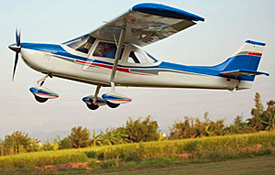
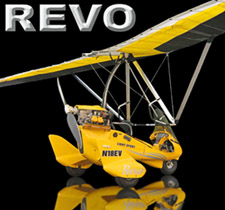
Evolution designed the rig and has components built in the USA by contractors near their home base. Formerly, Evolution worked with Powrachute, but they’ve since shifted to local resources to enhance quality control.
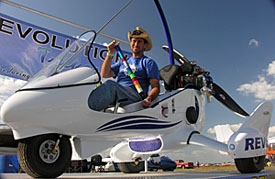
* Though you probably didn’t realize, Pipistrel — maker of sleek machines like Virus, Sinus, and Taurus fame — also makes a weight shift design.
 I am only aware of one company* in the USA that offers you a choice of a conventional three-axis fixed wing or a weight-shift control (WSC) flexwing. Why do this? Simple. Not all pilots want the same kind of aircraft and some of us like both kinds of flying.
It happens that the boys from Zephyr Hills airport have two interesting machines and you ought to know about them. “Boys” in this case refers to Abid Farooqui, Larry Mednick, and Phil Mednick; the latter are a son and father combo. Abid and Larry are trike guys while Phil is the fixed wing fellow and they display not only expertise, but as the impressive Revo development shows, they bring genuine creativity to the aircraft. This trio of talent operates several businesses, including a flight school.
One company, Apollo Aircraft, offers the Columbian-designed Ibis Magic as well as the Apollo LSA (formerly Apollo Fox).
I am only aware of one company* in the USA that offers you a choice of a conventional three-axis fixed wing or a weight-shift control (WSC) flexwing. Why do this? Simple. Not all pilots want the same kind of aircraft and some of us like both kinds of flying.
It happens that the boys from Zephyr Hills airport have two interesting machines and you ought to know about them. “Boys” in this case refers to Abid Farooqui, Larry Mednick, and Phil Mednick; the latter are a son and father combo. Abid and Larry are trike guys while Phil is the fixed wing fellow and they display not only expertise, but as the impressive Revo development shows, they bring genuine creativity to the aircraft. This trio of talent operates several businesses, including a flight school.
One company, Apollo Aircraft, offers the Columbian-designed Ibis Magic as well as the Apollo LSA (formerly Apollo Fox).
A5 flight testing continues. photo courtesy ICON Aircraft

Concept of revised Transition design. photo courtesy Terrafugia

Finding the middle road between air and ground regulations. photo courtesy Terrafugia
Two of the best-promoted and most interesting LSA projects – and two of the most delayed getting to market – are back in the news. Icon Aircraft, a startup company created to produce the sexy composite A5 amphibian, just snagged $25 million in funding to help complete remaining design issues, tool up for production and begin cranking out airplanes. *** The company reports around 500 A5 orders on the books, at $139,000 per. A few months of flight testing remain to be completed, along with a new wing (reportedly for better spin resistance and directional stability), which means the production target date has been pushed back again, this time to the last quarter of 2012. *** Reported among the new crop of investors are Eric Schmidt of Google, Satyen Patel, formerly of Nike and Phil Condit, former CEO of Boeing, and some “undisclosed” Silicon Valley entrepreneurs. The initial infusion of greenbacks will be $15 million, with an option for $10 million more. *** Meanwhile, regarding the flying car… er, “roadable aircraft,” the always press-visible Terrafugia recently got a nod from the National Highway Traffic Safety Administration when it granted the company’s application for a temporary exemption for its Transition flying car (or driving airplane… oh, heck, it’s just easier to say flying car).The exemption relaxes four federal vehicle safety standards requirements for the Transition, acknowledging that complying with the standards at this point in the ever-more-costly aircar would impose a condition of substantial economic hardship on the company and also grant more time to find safe alternatives to current automotive safety standards. *** Nonetheless, these are temporary exemptions. And Terrafugia had asked for a longer time period for two of the four exemptions. *** The company cited its 500 potential jobs by 2015 as partial justification for requesting the exemptions, and the agency took that into consideration as well as the overall occupant safety factor. One selling point was Terrafugia’s contention that the Transition increases pilot safety, since it can land at any airport in worsening VFR conditions and continue to the destination by road. Boy, those folks know how to articulate every possible benefit out of their concept. *** The point here would seem to be that the Transition would reduce potential VFR-into-IMC accidents because pilots wouldn’t be tempted to continue flights in bad weather in deterioriating weather. Of course, that’s only common sense for non-IFR pilots, a legal requirement as well, but as we all know, pilots get in trouble this way all the time, with occasional disastrous results. *** Exemption periods of one or three years included tire and rim selection requirements, glazing materials (windows and windscreen), occupant crash protection (advanced — and heavy — air bags) and electronic stability control systems. One can appreciate the difficulty of having to comply with not only aircraft but also automobile regulations, each set of which is tough enough to meet for one-medium vehicles. *** One teaching point for those inclined to scoff at the need to “bend” the rules: the glazing exemption deals with the potential safety hazard that traditional laminated car safety glass presents to pilots when shattered… it can cobweb something fierce. Imagine you get a bird strike front and center on final approach and can’t see forward. You could pull a Lindbergh and look out the side window, but you get the point. *** Significant weight penalty from auto glass is another consideration, so the exemption allows for time to develop polycarbonate materials with comparable protection for the occupants, at less weight, while still resisting shattering or crazing. *** The many design and regulatory challenges have again postponed flight testing of the 2nd, redesigned Transition prototype (the first, which flew briefly, had a canard), until at least March of 2012.
 Two of the best-promoted and most interesting LSA projects – and two of the most delayed getting to market – are back in the news. Icon Aircraft, a startup company created to produce the sexy composite A5 amphibian, just snagged $25 million in funding to help complete remaining design issues, tool up for production and begin cranking out airplanes. *** The company reports around 500 A5 orders on the books, at $139,000 per. A few months of flight testing remain to be completed, along with a new wing (reportedly for better spin resistance and directional stability), which means the production target date has been pushed back again, this time to the last quarter of 2012. *** Reported among the new crop of investors are Eric Schmidt of Google, Satyen Patel, formerly of Nike and Phil Condit, former CEO of Boeing, and some “undisclosed” Silicon Valley entrepreneurs. The initial infusion of greenbacks will be $15 million, with an option for $10 million more.
Two of the best-promoted and most interesting LSA projects – and two of the most delayed getting to market – are back in the news. Icon Aircraft, a startup company created to produce the sexy composite A5 amphibian, just snagged $25 million in funding to help complete remaining design issues, tool up for production and begin cranking out airplanes. *** The company reports around 500 A5 orders on the books, at $139,000 per. A few months of flight testing remain to be completed, along with a new wing (reportedly for better spin resistance and directional stability), which means the production target date has been pushed back again, this time to the last quarter of 2012. *** Reported among the new crop of investors are Eric Schmidt of Google, Satyen Patel, formerly of Nike and Phil Condit, former CEO of Boeing, and some “undisclosed” Silicon Valley entrepreneurs. The initial infusion of greenbacks will be $15 million, with an option for $10 million more.
